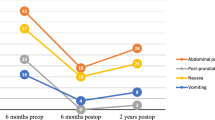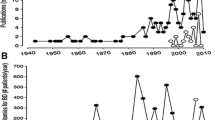Abstract
Purpose
Current literature for resolution of abdominal pain after cholecystectomy in children with biliary dyskinesia shows variable outcomes. We sought to compare early outcomes with long-term symptom resolution in children.
Methods
Telephone surveys were conducted on children who underwent cholecystectomy for biliary dyskinesia between January 2000 and January 2011 at two centers. Retrospective review was performed to obtain demographics and short-term outcomes.
Results
Charts of 105 patients’ age 7.9–19 years were reviewed; 80.9 % were female. All were symptomatic with an ejection fraction (EF) <35 % or pain with cholecystokinin administration. At the postoperative visit, 76.1 % had resolution of symptoms. Fifty-six (53.3 %) patients were available for follow-up at median 3.7 (1.1–10.7) years. Of these, 34 (60.7 %) reported no ongoing abdominal pain. Of the 22 patients with persistent symptoms, satisfaction score was 7.3 ± 2.7 (scale of 1–10) and 19 (86.4 %) were glad that they had a cholecystectomy performed. EF, body mass index percentile (BMI %), and pain with cholecystokinin (CCK) were not predictive of ongoing pain at either follow-up periods.
Conclusion
Short-term symptom resolution in children undergoing cholecystectomy for biliary dyskinesia is not reflective of long-term results. Neither EF, BMI % nor pain with CCK was predictive of symptom resolution. The majority of patients with ongoing complaints do not regret cholecystectomy.

Similar content being viewed by others
References
Mehta S, Lopez ME, Chumpitazi BP et al (2012) Clinical characteristics and risk factors for symptomatic pediatric gallbladder disease. Pediatrics 129:e82–e88
Campbell BT, Narasimhan NP, Golladay ES et al (2004) Biliary dyskinesia: a potentially unrecognized cause of abdominal pain in children. Pediatr Surg Int 20:579–581
Al-Homaidhi HS, Sukerek H, Klein M et al (2002) Biliary dyskinesia in children. Pediatr Surg Int 18:357–360
Michail S, Preud’Homme D, Christian J et al (2001) Laparoscopic cholecystectomy: effective treatment for chronic abdominal pain in children with acalculous biliary pain. J Pediatr Surg 36:1394–1396
Scott Nelson R, Kolts R, Park R et al (2006) A comparison of cholecystectomy and observation in children with biliary dyskinesia. J Pediatr Surg 41:1894–1898
Delgado-Aros S, Cremonini F, Bredenoord AJ et al (2003) Systematic review and meta-analysis: does gall-bladder ejection fraction on cholecystokinin cholescintigraphy predict outcome after cholecystectomy in suspected functional biliary pain. Aliment Pharmacol Ther 18:167–174
Vegunta RK, Raso M, Pollock J et al (2005) Biliary dyskinesia: the most common indication for cholecystectomy in children. Surgery 138:726–731
Haricharan RN, Proklova LV, Aprahamian CJ et al (2008) Laparoscopic cholecystectomy for biliary dyskinesia in children provides durable symptom relief. J Pediatr Surg 43:1060–1064
Defining childhood obesity and overweight for professionals. 2009. Centers for Disease Control and Prevention. 22 Sept. 2009 http://www.cdc.gov/obesity/childhood/defining.html
Maxwell D, Thompson S, Richmond B et al (2012) Quality of life after laparoscopic cholecystectomy for biliary dyskinesia in the pediatric population: a pilot study. Am Surg 78:111–118
Brownie E, Cusick RA, Perry DA et al (2011) Pathologic changes in biliary dyskinesia. J Pediatr Surg 46:879–882
Ducoin C, Faber R, Ilagan M, et al. (2012) Normokinetic biliary dyskinesia: a novel diagnosis. Surg Endosc. [Epub ahead of print]
Morris-Stiff G, Falk G, Kraynak L et al (2011) The cholecystokin provocation HIDA test: recreation of symptoms is superior to ejection fraction in predicting medium-term outcomes. J Gastrointest Surg 15:345–349
Constantinou C, Sucandy I, Ramenofsky M (2008) Laparoscopic cholecystectomy for biliary dyskinesia in children: report of 100 cases from a single institution. Am Surg 74:587–592
Carney DE, Kokoska ER, Grosfeld JL et al (2004) Predictors of successful outcome after cholecystectomy for biliary dyskinesia. J Pediatr Surg 39:813–816
Author information
Authors and Affiliations
Corresponding author
Rights and permissions
About this article
Cite this article
Knott, E.M., Fike, F.B., Gasior, A.C. et al. Multi-institutional analysis of long-term symptom resolution after cholecystectomy for biliary dyskinesia in children. Pediatr Surg Int 29, 1243–1247 (2013). https://doi.org/10.1007/s00383-013-3343-3
Accepted:
Published:
Issue Date:
DOI: https://doi.org/10.1007/s00383-013-3343-3




